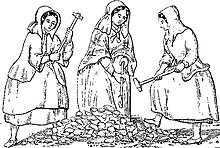Gook (headgear)

A gook was a piece of protective headgear worn by bal maidens (female manual labourers in the mining industries of Cornwall and Devon).[1] The gook was a bonnet which covered the head and projected forward over the face, to protect the wearer's head and face from sunlight and flying debris.[1][2] Bal maidens often worked outdoors or in very crude surface-level shelters,[3] and the gook also gave protection from extreme weather conditions.[1] By covering the ears, gooks protected the ears from the noisy industrial environment.[1]
While there was some regional variation in style, gooks would generally be tied under the chin and around the neck, and fall loose from the neck over the shoulders to protect the shoulders and upper arms.
In the 19th century bal maidens began to wear straw hats in summer instead of cotton gooks.[1] By the end of the 19th century, these straw bonnets had largely replaced the gook year-round.[5] By this time the Cornish mining industry was in terminal decline, and very few bal maidens remained in employment.[6]

When some bal maidens were re-hired to work in a temporarily expanded mining industry during the
In 1921
See also
- Mining helmet
Notes
- ^ The end of the use of bal maidens did not mean the end of female workers in those mines that survived; women continued to work in administrative roles until the final collapse of the Cornish mining industry in the late 20th century. See Mayers, Dangerous Place, p. 30 and Mayers, Bal Maidens, p. 164.
- ^ As of July 2012[update] plans were being made to reopen some Cornish metal mines, as rising prices had made Cornish mining economically viable again. See Gallacher.
References
- ^ a b c d e Mayers, Dangerous Place, p. 8.
- ^ Buckley, p. 24.
- ^ Mayers, Bal Maidens, p. 75.
- ^ a b c d Mayers, Bal Maidens, p. 66.
- ^ a b c d Mayers, Bal Maidens, p. 67.
- ^ a b Mayers, Dangerous Place, p. 13.
- ^ Mayers, Bal Maidens, p. 22.
- ^ Mayers, Bal Maidens, p. 15.
- ^ Mayers, Bal Maidens, p. 145.
- ^ Mayers, Bal Maidens, p. viii.
- ^ Gallacher.
Bibliography
- Buckley, Allen (2010). Cornish Bal Maidens. Penryn: Tor Mark. OCLC 688361470.
- Gallacher, Neil (20 July 2012). "New operations chief for South Crofty mine". BBC News. Retrieved 22 July 2012.
- Mayers, Lynne (2008). A Dangerous Place to Work! Women & Children of the Devon & Cornwall Mining Industries 1300 to 1970. Cinderford: Blaize Bailey Books. OCLC 688362135.
- Mayers, Lynne (2008) [2004]. Bal Maidens: Women and Girls of the Cornwall and Devon Mines (2nd ed.). Cinderford: Blaize Bailey Books. OCLC 663435621. (1st edition published 2004 by The Hypatia Trust, Penzance as Balmaidens)
Further reading
- Mayers, Lynne (2010). The Godolphin Bal Maidens: Women and girls at the mines of the Mount's Bay area. Cinderford: Blaize Bailey Books. OCLC 772956873.
- Mayers, Lynne (2012). The North Coast Bal Maidens: Women and girls at the mines (Portreath to Padstow). Cinderford: Blaize Bailey Books. ISBN 978-0-9556896-6-6.
- Mayers, Lynne (2011). The St Austell Bal Maidens: Women and girls at the mines and clay works. Cinderford: Blaize Bailey Books. ISBN 978-0-9556896-5-9.
- Mayers, Lynne (2011). The Tamar Bal Maidens: Women and girls at the mines of East Cornwall and West Devon. Cinderford: Blaize Bailey Books. ISBN 978-0-9556896-4-2.
External links
- Bal Maidens & Mining Women Information, publications and resources on bal maidens and other female mineworkers
